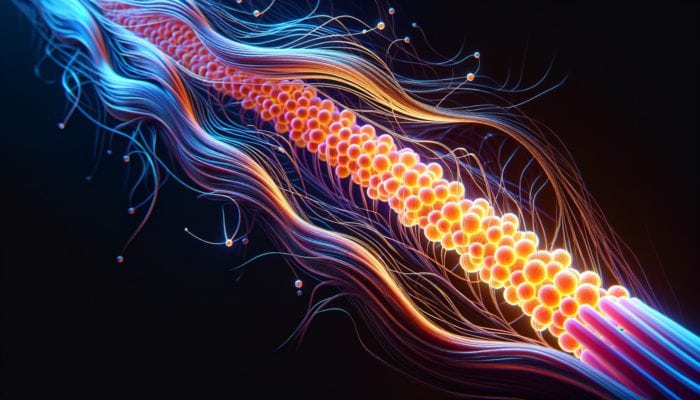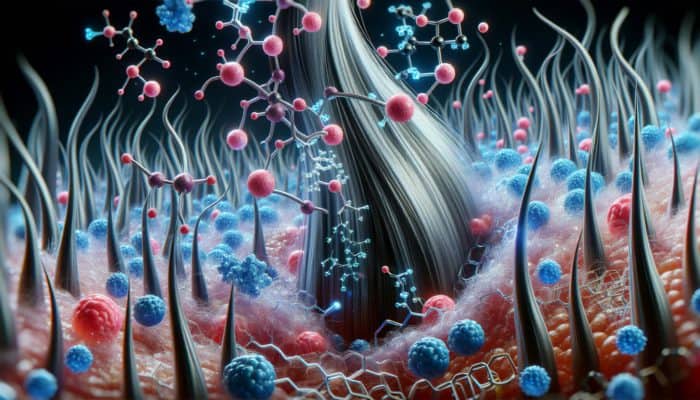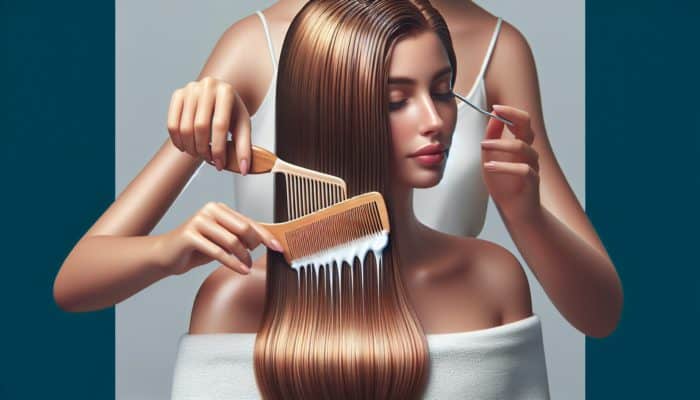Exploring the Crucial Importance of Protein for Optimal Hair Health
Unpacking the Role of Protein in Strengthening Hair

Protein serves as a fundamental building block for hair, playing an indispensable role in maintaining its strength and overall structural integrity. The primary protein present in hair is keratin, which forms the robust framework of each individual hair strand. When the body lacks sufficient protein, hair becomes vulnerable, leading to fragility, increased breakage, and a lacklustre appearance. This structural integrity is crucial, allowing hair to withstand various environmental stressors including UV rays, pollution, and the damaging effects of heat styling. Furthermore, protein is vital for facilitating the hair growth cycle, ensuring that new strands emerge strong and healthy.
To achieve and sustain vibrant, healthy hair, it is essential to incorporate protein into your hair care routine. This can be accomplished through dietary sources such as eggs, fish, and legumes, alongside specialised hair treatments that are designed to repair and nourish damaged strands. By guaranteeing that your hair receives an adequate supply of protein, you can preserve its health and appearance, irrespective of its type or texture. Ultimately, recognising the significance of protein in hair health empowers you to take proactive measures towards hair restoration and ongoing maintenance.
How Protein Treatments Effectively Repair Hair Damage
Protein treatments are expertly formulated to fill the gaps within the hair's cuticle, thereby effectively restoring its inherent strength and flexibility. When hair sustains damage, the cuticle, which acts as the outer protective layer, can become compromised, exposing the inner hair structure and resulting in breakage and a loss of shine. Protein treatments directly address this concern by supplying the essential amino acids that hair needs to rebuild its structure, effectively repairing damage and enhancing overall hair health.
The unique formulations of many protein treatments allow for deep penetration into the hair shaft, ensuring that the restorative properties reach the areas in most need of repair. This targeted approach significantly aids in reducing breakage, enhancing elasticity, and improving the hair's natural shine. Regular application of protein treatments not only repairs existing damage but also serves as a preventative measure, fortifying hair against daily wear and tear. Therefore, understanding how protein can effectively rejuvenate damaged hair is essential for anyone aspiring to revitalise their locks.
Uncovering the Extensive Benefits of Protein for All Hair Types
Protein treatments offer a multitude of benefits for all hair types, ranging from fine to coarse, by delivering critical nutrients that enhance the hair's resilience and overall appearance. For those with fine hair, which is often more susceptible to damage and prone to losing its shape, protein provides the necessary strength and support. Fine hair typically benefits from lighter protein treatments to avoid feeling weighed down, while still receiving the structural reinforcement that protein offers.
In contrast, medium and thick hair types can generally withstand more intensive protein treatments. These treatments work to bolster the natural structure of the hair, improving its resilience against heat styling and environmental stressors. Additionally, coarse hair can experience significant advantages from protein treatments, as it is often drier and more prone to frizz. By integrating protein into your hair care routine, coarse hair can achieve enhanced moisture retention and a smoother texture.
Ultimately, the benefits of protein are relevant to all hair types, solidifying its status as a core component of any effective hair care regimen. By tailoring your protein treatments to address your specific hair type, you can ensure that your tresses remain healthy, robust, and visually appealing.
Proven Strategies for Revitalising Damaged Hair Using Protein

Recognising Symptoms of Protein Deficiency in Hair
Identifying the signs of protein deficiency in hair is crucial for selecting the most suitable treatment to restore vitality. Common symptoms of protein-deficient hair often encompass increased breakage, diminished elasticity, and a coarse texture. Here are some prevalent indicators to watch for:
- Increased hair fall, particularly noticeable during brushing or washing
- Loss of elasticity, resulting in hair that fails to bounce back after stretching
- Rough or dry texture that feels brittle to the touch
- Dullness or lack of shine, indicating insufficient moisture
- Split ends or fraying, especially at the tips of the hair
- Frizz or unmanageable hair that resists styling efforts
Should you observe any of these signs, it may suggest that your hair is in need of a protein boost. Understanding your hair's specific requirements can guide you in choosing the most appropriate treatment, ensuring that your locks receive the nourishment necessary to thrive. By promptly addressing protein deficiency, you can avert further damage and encourage healthier, more resilient hair over time.
Determining the Optimal Frequency for Protein Treatments
The frequency of protein treatments should be customised based on your hair's condition and type. Overusing these treatments can lead to protein overload, causing hair to become dry and brittle. To strike the right balance, it is essential to evaluate your hair's individual needs and adjust your treatment timeline accordingly. As a general guideline, protein treatments can be applied every 4-6 weeks for most hair types.
However, those with more significant damage may benefit from applying a protein treatment every 2-4 weeks until noticeable improvement is observed. Pay close attention to how your hair responds after each treatment, as this will assist you in determining the ideal frequency for your unique circumstances. If your hair begins to feel stiff or excessively dry post-treatment, it's a clear indication to reduce the frequency or incorporate more moisture-rich products into your routine.
Consulting with a professional stylist can provide invaluable insights into your hair's specific needs and help establish a personalised protein treatment schedule that aligns with your goals. By balancing protein treatments with regular moisturising care, you can effectively maintain the health and vibrancy of your hair.
Best Practices for Applying Protein Treatments Effectively

To maximise the effectiveness of protein treatments, it is paramount to apply them correctly. Following the manufacturer's guidelines while considering your hair's unique needs is vital for achieving optimal results. Begin by thoroughly cleansing your hair with a gentle shampoo to eliminate any product buildup or impurities, thus allowing the protein treatment to penetrate more effectively.
When applying the treatment, concentrate on the mid-lengths and ends of your hair, where damage is often most pronounced. Utilise a wide-tooth comb to evenly distribute the product, ensuring that each strand receives the necessary nourishment. After application, consider covering your hair with a shower cap or warm towel to create a warm environment, facilitating better absorption of the treatment into the hair shaft.
Allow the treatment to remain in your hair for the recommended duration, typically spanning from 10 to 30 minutes, depending on the specifics of the product. Rinse thoroughly with lukewarm water to eliminate any excess product, and follow up with a deep conditioning treatment to restore moisture and balance. This dual approach ensures that your hair receives both the protein it requires and the hydration essential for optimal health. By mastering these best practices, you can significantly enhance the efficacy of your protein treatments and promote healthier, stronger hair.
Diverse Types of Protein Treatments for Revitalising Damaged Hair
Understanding Hydrolyzed Protein Treatments
Hydrolyzed proteins are proteins that have been broken down into smaller molecules, enabling them to penetrate the hair shaft more easily and provide deep conditioning and repair. These proteins are often derived from sources such as wheat, soy, or keratin, specifically formulated to effectively strengthen damaged hair. Hydrolyzed protein treatments are especially beneficial for individuals with porous or high-porosity hair, as they assist in filling gaps in the cuticle and restoring a smoother, more resilient structure.
Common examples of hydrolyzed proteins featured in treatments include:
- Hydrolyzed keratin
- Hydrolyzed wheat protein
- Hydrolyzed silk protein
- Hydrolyzed soy protein
- Hydrolyzed collagen
When selecting a hydrolyzed protein treatment, consider your hair's specific needs and opt for a product that aligns with those requirements. Regular use of these treatments can lead to noticeable improvements in hair strength, elasticity, and overall health, making them an indispensable addition to any hair care regimen.
Transforming Damaged Hair with Keratin Treatments
Keratin treatments are specifically designed to help rebuild the natural protein structure of hair, smoothing the cuticle and minimising frizz. These treatments are particularly advantageous for those with chemically treated or heat-damaged hair, as they work to restore the hair's inherent strength and resilience. Keratin is a critical structural component of hair, and replenishing it can significantly enhance manageability and shine.
Unlike traditional protein treatments that may leave hair feeling stiff or crunchy, keratin treatments typically provide a more supple finish, facilitating easier styling and reduced frizz. This transformative effect can dramatically elevate the appearance of damaged hair, making it look healthier and more vibrant. Furthermore, keratin treatments can establish a protective barrier around the hair shaft, shielding it from future damage caused by heat styling or environmental factors.
For optimal results, consider incorporating keratin treatments into your hair care routine, particularly if you frequently use heat tools or have undergone chemical processes. By doing so, you can help restore your hair's natural beauty and prevent further damage, ensuring your locks remain strong, shiny, and resilient.
Advantages of Plant-Based Protein Treatments
Plant-based proteins, sourced from wheat, soy, or silk, offer a natural alternative for hair repair. These proteins provide essential nutrients that nourish and strengthen hair, often accompanied by additional benefits such as moisture and nourishment. Plant-based treatments are generally gentler on the hair and can be an ideal choice for individuals with sensitivities to animal-derived proteins or harsh chemicals.
One notable advantage of plant-based protein treatments is their ability to promote a healthy scalp environment. Many plant proteins include vitamins and minerals that nourish the scalp, fostering optimal conditions for hair growth. Additionally, these treatments are often rich in antioxidants, which can protect hair from environmental stressors and free radicals.
When selecting a plant-based protein treatment, look for products that prioritise natural ingredients while steering clear of harsh chemicals or synthetic additives. By incorporating these treatments into your hair care routine, you can achieve significant improvements in hair strength, elasticity, and hydration while embracing a more organic approach to hair care.
How Collagen Treatments Fortify Damaged Hair
Collagen treatments deliver essential proteins that reinforce hair structure, enhancing its strength and elasticity. As a naturally occurring protein in the body, collagen plays a crucial role in maintaining the structural integrity of hair, skin, and nails. With age, collagen production diminishes, potentially resulting in thinner, weaker hair. Integrating collagen treatments into your hair care regimen can counter these effects and promote healthier, more resilient hair.
By applying collagen treatments, you can effectively restore lost strength and elasticity to your hair, enhancing its overall appearance. These treatments replenish essential amino acids that contribute to the hair's structural integrity, helping to mitigate breakage and foster healthy growth. Additionally, collagen treatments can improve moisture retention within the hair shaft, leading to enhanced hydration and shine.
For those facing damage from environmental factors or harsh chemical treatments, collagen treatments can be a valuable addition to your hair care routine. By regularly using collagen-infused products, you can maintain youthful, vibrant hair and counteract the effects of aging or damage over time.
The Benefits of Amino Acid Treatments for Hair Repair
Amino acid treatments provide the essential building blocks of hair proteins, facilitating repair and moisture retention. These treatments are especially beneficial for individuals with damaged or chemically treated hair, as they assist in restoring the hair's natural structure and improving overall health. Amino acids play a crucial role in synthesising keratin, making them vital for maintaining hair strength and resilience.
One of the primary advantages of amino acid treatments is their ability to enhance moisture retention within the hair shaft. By attracting and holding moisture, these treatments can help combat dryness and frizz, resulting in smoother, more manageable hair. Moreover, amino acids can strengthen the hair's cuticle, decreasing the likelihood of breakage and split ends.
When integrating amino acid treatments into your hair care routine, seek out products featuring a blend of essential amino acids, such as arginine, cysteine, or proline. Regular application of these treatments can lead to significant improvements in hair strength, elasticity, and overall appearance, making them an invaluable aspect of any effective hair care regimen.
Assessing Your Hair's Protein Needs
Identifying Symptoms of Protein Overload in Hair
Experiencing protein overload can result in dry, brittle hair and increased breakage. Being able to recognise these symptoms is crucial for making necessary adjustments to your hair care routine. Common indicators of protein overload include:
- Hair that feels stiff and crunchy after a protein treatment
- Increased breakage, particularly during brushing or styling
- Hair that appears devoid of moisture and feels rough to the touch
- Difficulty in styling, as hair may become unmanageable
If you encounter any of these symptoms, it may be necessary to reduce the frequency of protein treatments or incorporate a greater variety of moisture-rich products into your regimen. Maintaining a balance between protein and moisture is essential for healthy hair, as both elements play critical roles in overall hair health. By remaining vigilant about the signs of protein overload, you can ensure that your hair receives the appropriate care and nourishment it needs to thrive.
Conducting a Simple Hair Elasticity Test
A hair elasticity test can provide valuable insights into whether your hair requires additional protein. This simple test can be performed at home using just a few strands of hair. To conduct the test, follow these straightforward steps:
- Begin with clean, damp hair. It is best to perform the test after washing your hair.
- Take a single strand of hair and gently stretch it between your fingers.
- If the hair stretches and returns to its original form, it exhibits good elasticity.
- If the hair snaps easily without stretching, it may indicate a lack of protein.
Incorporating this quick and easy test into your hair care routine can enhance your understanding of your hair's specific needs. If you discover that your hair lacks elasticity, consider introducing protein treatments to restore its strength and resilience. Regularly checking your hair's elasticity can assist you in maintaining a healthy balance between protein and moisture, ensuring that your locks remain vibrant and strong.
Recognising Signs of Protein Deficiency in Hair
Indicators of protein deficiency in hair include strands that feel weak, stretch excessively, or break easily. Being able to recognise these signs can guide you in selecting the appropriate protein treatment for your hair. In addition to the previously mentioned symptoms, be vigilant for:
- Hair that lacks shine and appears dull
- Rough or dry texture that feels brittle to the touch
- Frizz or flyaways that are challenging to manage
- Frequent split ends or breakage at the hair shaft
If you experience these symptoms, it is essential to take action to address the protein deficiency. This may involve incorporating protein-rich products into your hair care routine or seeking professional advice on suitable treatments. By understanding the indicators of protein deficiency, you can take proactive measures to restore your hair's health and ensure it remains strong, shiny, and resilient.
Determining the Frequency of Protein Treatments
Protein treatments should be administered based on your hair's specific needs, typically every 4-6 weeks. Overuse can lead to protein overload, making it vital to monitor your hair's response. If your hair feels excessively dry or brittle following a treatment, this may indicate the need to reduce the frequency or balance your regimen with moisture-rich products.
For those with significant damage or high-porosity hair, you might consider employing protein treatments more frequently, potentially every 2-4 weeks, until your hair begins to show improvement. Conversely, if your hair feels strong and healthy, you may extend the intervals between treatments.
Regularly evaluating your hair's condition is key to determining the ideal frequency of protein treatments. Keeping a hair care journal can be beneficial in tracking how your hair responds over time, making it easier to adjust your routine as necessary. By remaining attuned to your hair's requirements, you can effectively maintain its health and vitality.
Understanding the Impact of Your Diet on Hair's Protein Levels
Certainly, a diet rich in protein plays a significant role in supporting hair health. Including foods such as eggs, nuts, lean meats, and legumes can help sustain adequate protein levels in your hair. Since hair is primarily composed of keratin—a type of protein—ensuring your diet is protein-rich is essential for healthy hair growth and maintenance.
In addition to protein, it is equally important to incorporate a variety of vitamins and minerals in your diet to bolster overall hair health. Nutrients such as biotin, zinc, and vitamins A and E are vital for maintaining robust, vibrant hair. By focusing on a balanced diet that encompasses a wide array of nutrients, you can nurture your hair's health from within, promoting growth and reducing the risk of damage. Consequently, consider adopting a holistic approach to hair care by merging proper nutrition with targeted hair treatments for optimal results.
Strategic Approaches for Reviving Damaged Hair with Protein
Integrating Protein into Your Hair Care Regimen
Integrating protein into your hair care routine may involve utilising protein-rich shampoos, conditioners, or masks. Achieving a balance between protein and moisture is key to maintaining healthy hair. Start by choosing shampoos and conditioners that contain hydrolyzed proteins or amino acids to ensure that your hair receives the necessary nutrients throughout your washing routine.
Additionally, contemplate incorporating weekly protein masks or treatments specifically designed to target damaged hair. These can be sourced from professional salon products or created at home with DIY recipes. Dedicating one day each week to deep conditioning treatment provides your hair with the intensive care it needs for recovery.
Furthermore, be diligent in monitoring your hair's response to these protein-rich products. If you begin to notice signs of protein overload, such as increased dryness or brittleness, consider alternating protein treatments with hydrating products. This balanced approach allows you to tailor your regimen according to your hair's needs, ultimately resulting in healthier, stronger hair.
Best Protein Sources for DIY Hair Treatments
DIY treatments can incorporate ingredients such as eggs, yogurt, or avocado, which are rich in protein and can effectively nourish and repair damaged hair. Crafting your own treatments at home enables you to customise the ingredients to meet your hair's specific needs. Here are some excellent protein sources for DIY hair treatments:
- Eggs: Rich in protein and biotin, eggs strengthen and repair hair.
- Yogurt: Packed with protein and lactic acid, yogurt helps to moisturise and smooth the hair.
- Avocado: Loaded with healthy fats and proteins, avocado nourishes and hydrates dry hair.
- Honey: While not a direct protein source, honey aids in locking in moisture and enhancing the effectiveness of protein treatments.
To create a simple DIY protein treatment, combine one egg with a few tablespoons of yogurt and a mashed avocado. Apply the mixture to clean, damp hair, allowing it to sit for 20-30 minutes before rinsing thoroughly. By utilising these natural ingredients, you can effectively nourish and repair your hair while avoiding harsh chemicals often found in commercial products.
Maintaining Protein Balance in Your Hair Care Routine
Sustaining a balance between protein and moisture is fundamental for healthy hair. Overloading on protein can be just as detrimental as a deficiency, leading to dryness and brittleness. To ensure your hair remains well-balanced, consider incorporating both protein-rich and moisturising products into your hair care routine.
Begin by establishing a weekly schedule that alternates between protein treatments and deep conditioning masks. For example, use a protein treatment one week and a hydrating mask the next week. This strategy allows you to provide your hair with essential nutrients while also replenishing moisture.
Additionally, remain attentive to your hair's reaction to these treatments. If you notice signs of protein overload, such as increased dryness or breakage, adjust the frequency of protein applications and increase the use of moisturising products. By being vigilant about your hair's needs, you can maintain a healthy balance that promotes strong, vibrant hair.
Determining the Appropriate Frequency for Protein Treatments on Damaged Hair
Protein treatments should be employed judiciously to prevent protein overload. The ideal frequency for applying protein treatments depends on your hair type and the extent of damage. For most hair types, a protein treatment every 4-6 weeks is advisable. However, if your hair is severely damaged or porous, you may need to use protein treatments more frequently, perhaps every 2-4 weeks.
Monitoring your hair's response to these treatments is essential. If you observe an enhancement in strength and elasticity, you may choose to extend the intervals between treatments. Conversely, if your hair becomes dry or brittle following a treatment, it may be time to lessen the frequency or incorporate more moisture-focused products into your regimen.
Regularly assessing your hair's condition, ideally through a hair care journal, can help you keep track of how your hair responds to each treatment and make necessary adjustments. By finding the right balance of protein and moisture, you can foster healthier, more resilient hair.
Selecting the Right Protein Treatment for Your Hair
Key Factors to Consider When Choosing a Protein Treatment
When selecting a protein treatment, it is vital to consider your hair type, the level of damage, and any sensitivities or allergies. Choosing the right treatment can significantly impact its effectiveness. Here are some essential factors to keep in mind:
- Hair type: Fine hair may require lighter protein treatments, while thicker or coarser hair might benefit from more intense formulations.
- Damage level: Evaluate the severity of your hair damage and select a treatment that addresses your specific needs.
- Ingredients: Review the ingredient list to avoid allergens or irritants, and opt for natural ingredients whenever possible.
- Brand reputation: Consider brands with a strong reputation for quality and effectiveness in the hair care industry.
By taking these factors into account, you can choose a protein treatment that aligns with your hair's unique needs and delivers optimal results. Consulting with a professional stylist can also provide valuable insights and recommendations tailored to your specific situation, ensuring that your hair receives the best possible care.
Evaluating the Effectiveness of a Protein Treatment
Assessing the effectiveness of a protein treatment involves observing changes in hair texture, strength, and overall health. After using a protein treatment, pay close attention to how your hair feels and looks. If you notice improvements in elasticity, shine, and manageability, this is a strong indication that the treatment is working effectively.
Conducting regular hair checks to evaluate your strands' strength and resilience is beneficial. Look for signs of reduced breakage, improved moisture retention, and enhanced overall appearance. Keep in mind that it may take several applications before noticeable improvements occur, so be patient and consistent with your treatments.
Additionally, consider maintaining a hair care journal to document your experiences with different products and treatments. This record can help you identify which products work best for your hair and guide you in making informed decisions moving forward. By staying attuned to your hair's response to protein treatments, you can ensure that you are on the right path to achieving healthier, stronger hair.
Potential Side Effects of Protein Treatments
Potential side effects of protein treatments may include protein overload, allergic reactions, or increased dryness. Being aware of these potential issues can help you use treatments safely and effectively. Protein overload can occur if treatments are applied too frequently, resulting in dry, brittle hair that is susceptible to breakage. To prevent this, monitor your hair's response and adjust the frequency of treatments as needed.
Allergic reactions are another possibility, particularly for individuals with sensitivities to specific ingredients. Always perform a patch test before applying a new product to your hair, especially if it contains unfamiliar components. If you experience any irritation or discomfort, discontinue use immediately.
Lastly, if your hair becomes excessively dry or brittle after using a protein treatment, it may indicate that your hair is receiving too much protein. In this case, consider incorporating more moisturising products into your routine to restore balance. By being mindful of these potential side effects, you can maximise the benefits of protein treatments while minimising any adverse effects.
Strategies for Maintaining Healthy Hair Following Protein Treatments
Preventing Future Hair Damage
Preventing future damage requires implementing regular conditioning, avoiding heat styling, and utilising protective products. A balanced hair care routine is essential for long-term hair health, so consider adopting the following practices:
- Regular trims: Schedule haircuts every 6-8 weeks to eliminate split ends and maintain healthy length.
- Moisturising treatments: Employ deep conditioning masks regularly to keep hair hydrated and nourished.
- Heat protection: Always apply a heat protectant prior to using styling tools to shield your hair from thermal damage.
- Gentle cleansing: Choose sulfate-free shampoos to minimise the stripping of natural oils and maintain moisture balance.
By adopting these preventative measures, you can significantly reduce the risk of future hair damage and maintain the strength and vitality of your locks. Consistency and patience are critical, as achieving healthy hair necessitates a commitment to proper care and attention.
Best Practices for Sustaining Long-Term Hair Care
Ongoing care encompasses regular trims, using gentle products, and maintaining a balanced diet. Consistent care is vital for keeping hair healthy and strong. Begin by integrating regular haircuts into your routine to prevent split ends and promote healthy growth.
Select hair care products formulated specifically for your hair type, as this can enhance overall health and appearance. Avoid harsh chemicals and opt for sulfate-free shampoos and nourishing conditioners that provide essential hydration. Additionally, consider using a weekly deep conditioning mask to sustain moisture levels and promote shine.
Maintaining a balanced diet is equally important for ongoing hair health. Ensure that your meals are rich in protein, vitamins, and minerals to support hair growth and strength. By adopting these best practices, you can establish a robust hair care routine that promotes long-lasting health and beauty.
Monitoring Your Hair's Health Over Time
Monitoring hair health involves conducting regular assessments for changes in texture, strength, and growth. Keeping a hair care journal can be beneficial in tracking progress and adjusting your routine as necessary. Start by documenting your hair care practices, including any products used, treatments applied, and your hair's response over time.
Perform monthly evaluations of your hair's condition, noting any changes in texture, elasticity, or overall appearance. This routine assessment will enable you to identify trends and make necessary adjustments to your regimen. Additionally, consider taking regular photographs to visually document your hair's progress, as this can provide motivation and insight into the effectiveness of your hair care routine.
By remaining proactive and attentive to your hair's health, you can ensure that it remains strong, vibrant, and resilient for years to come.
Commonly Asked Questions About Protein Treatments
What is the typical timeframe to see results from protein treatments?
Results can vary, but many individuals notice enhancements in their hair's texture and strength within a few treatments, typically after 4-6 weeks of consistent use.
Are protein treatments safe for colour-treated hair?
Yes, protein treatments can be beneficial for colour-treated hair, as they assist in restoring strength and elasticity. Just exercise caution when selecting the right products to prevent further damage.
What are some natural protein sources for hair treatments?
Absolutely! Ingredients like eggs, yogurt, and avocado are excellent natural sources of protein that can be utilised in DIY hair treatments.
How can I identify if my hair is over-conditioned?
Signs of over-conditioning include limp, lifeless hair that lacks volume and is prone to breakage. If you notice this, reduce the frequency of conditioning treatments.
Can I use protein and moisture treatments together?
Yes! A balanced routine that incorporates both protein and moisture treatments can provide optimal care for your hair, ensuring it remains strong and hydrated.
What is the best method for applying protein treatments?
Apply protein treatments on clean, damp hair, focusing on the mid-lengths and ends. Use a wide-tooth comb to distribute evenly and adhere to the manufacturer's recommended processing time.
How can I tell if my hair is sensitive to protein?
If you experience increased breakage, dryness, or stiffness following protein treatments, your hair may be protein-sensitive and might require less frequent applications.
Are there specific products for fine hair that require protein?
Yes, look for lightweight protein treatments specifically formulated for fine hair to avoid weighing it down while still providing essential strength.
What type of protein treatment is best for curly hair?
Curly hair often benefits from keratin and hydrolyzed protein treatments, as they help to enhance curl definition while improving strength and reducing frizz.
How does my diet impact my hair's health?
A diet rich in protein, vitamins, and minerals supports hair health, encouraging stronger growth and resilience against damage. Including a variety of nutrient-dense foods is crucial for optimal results.
Connect with us on Facebook!
The Article: How to Revive Damaged Hair with Protein: Universal Guide appeared first on Amitys Hair Salon.
The Article Revive Damaged Hair with Protein: A Complete Guide Was Found On https://limitsofstrategy.com

